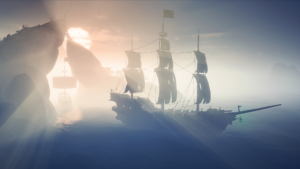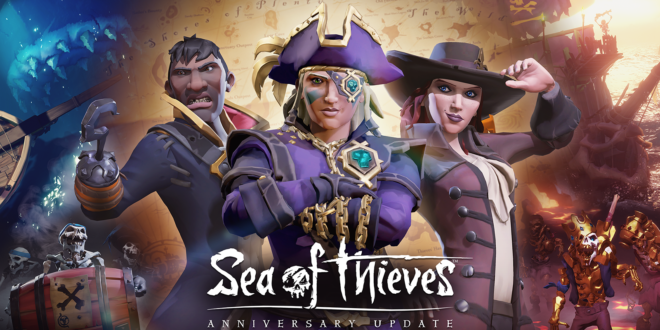My favourite thing about Sea of Thieves is not playing it. I know it’s an odd statement and don’t get me wrong: I do really love playing Sea of Thieves. But reading about people’s adventures in the game, seeing how they’re using it as a canvas, how they’re making it their own, how they’re strengthening friendships or going on incredible adventures with strangers is (almost) as good as playing the game itself.
I’ve rarely seen a game that provides players with such an avenue for discovery and exploration. There are other games that do that of course, plenty of others. But Sea of Thieves feels special to me because I’ve seen its positive impact on people’s mental health around me. Also, pirates are awesome. Sea of Thieves is not only a game to play, it’s somewhere you can go to forget about real life’s problems. And that’s very much what Rare set out to do when it first started working on its new IP five years ago.

“Ultimately the idea for Sea of Thieves can be distilled into a simple terminology that we use: players creating stories together,” senior designer Shelley Preston starts explaining. One thing that is abundantly clear as soon as we start our chat is Preston’s sheer passion for the game. Only a few minutes talking to her and you too would want to quit your job to go and create piratey things at Rare. She joined the studio 13 years ago as a tester, then climbed the ladder to designer and has now been senior designer for nearly six years. She’s witnessed the inception of Sea of Thieves from the very beginning.
“It was inspired by looking at this emerging trend where there were lots of videos online of people playing games in unique ways, using the game almost as a backdrop to have their own stories. So games like Day-Z or Eve Online, where all these really interesting, unique encounters were happening,” Preston continues. “We thought about how we could create a game where players could make their own stories in a shared social environment.
“And then at the same time we were obviously looking ahead to the future and thinking about streaming. At the time it was on that trajectory towards being as big as it is today and we were thinking about how perfect streaming would be for a game like this and how we could make a game where it was as watchable and shareable as it was playable.
“So really the context was making a game where players could create stories together that could be shared socially, so pirates didn’t actually come into it originally. It was just the concept and then we thought of lots of different ideas that we could put around that. And pirates was one of those ideas that just made a lot of sense – we all have a soft spot for pirates here and we just thought it would be perfect for bringing players together as there’s a lot of almost unspoken knowledge of pirates. If you put people in a pirate outfit they know what to do already. So that breaks the ice and gives people something to start roleplaying with and start creating the rules of their world.”
“Everything we built goes through that lens of: how can we make this social? How can we make this bring players together? How can we motivate players to bond as a crew?”
Preston can’t remember all the options Rare threw around apart from one that “might’ve been vampires or something,” she laughs. “It was ages ago and there were so many ideas! It was just different ideas that we could wrap around the same [concept], but none of them made as much sense as pirates.”
If it wasn’t for pirates being so universally cool then, we would all be trying to steal each other’s blood bags as vampires right now.
This also highlights the importance of having a solid concept to start with when developing a game, as a strong vision will help shape the title, its mechanics and features.
“Players creating stories together is the pillar that binds everything that we do in Sea of Thieves,” Preston continues, adding that Rare goes by the saying of ‘tools, not rules’ when it comes to creating mechanics. “So when we’re thinking about putting a feature in, say for example the treasure maps that players can hold in their hands, we will think about what you can do with that and will lay a very simple action that players can do. They can look at the map but because it’s about players creating stories together and it’s a social experience, they can show the map to other people. By showing the map, it doesn’t inherently do anything but it’s an action that you can do and that means that players can use that in so many different ways; they can use it functionally to actually show people where they need to dig for treasure, they can almost use it sarcastically if somebody’s gone to the wrong island, they can use it in a humorous way. So it’s about giving players tools and ways to have their own creative freedom. So that was a huge pillar for us.”

She gives another example of decisions made during development that were motivated by the purpose of building a community and bringing players together.
“Every feature that we worked on we put through that lens and the ship is probably the easiest way to communicate how this thinking impacted every facet of our design. So when we were building the ship, rather than having what a traditional game would have with a vehicle that you can control – so one person presses the button and gets control of the ship and they can do everything – we deliberately broke up the controls so that you need to work together to raise the anchor. You can do it alone but it’s faster together.
“We deliberately made it so that the person on the wheel has their view obscured by a sail so that you need to communicate with your crew. We put the map down below decks so that it is easier for you to communicate as a crew back and forth. And I think everything we built goes through that lens of: how can we make this social? How can we make this bring players together? How can we make this motivate players to cooperate and strengthen that bond as a crew?”
Not only did Sea of Thieves’ mechanics need to serve the greater purpose of the game, but they also needed to work and make sense in a shared environment, Preston continues.
 “When we’re bringing in features, we have to think about: how can we make something that impacts the wider social experience? So when we were looking at putting in treasure, which is obviously an amazing pirate trope, we went through many iterations of what that was.”
“When we’re bringing in features, we have to think about: how can we make something that impacts the wider social experience? So when we were looking at putting in treasure, which is obviously an amazing pirate trope, we went through many iterations of what that was.”
Having considered other options, such as being able to take items out of the treasure chests, Rare struck upon on the idea of digging up boxes of treasure – but not being able to open them.
“It’s then a physical item that you carry back to your ship,” Preston explains. “So not only does that bond you together as a crew, because you’re all protecting this item, but for other crews it’s a physical item that they come and try to steal from you and be piratey but they also can use it to trade or to be friendly. So it’s just about thinking about how we make our mechanics in a way that drives as many different social experiences as possible.”
SOLO SAILING
However, Rare did have to take one small detail into account: some people would want to play on their own.
“We always believed right from the start that the crew experience is the strength of Sea of Thieves. But we knew as we developed the game that not everyone wants to play that way and not everyone necessarily can either,” Preston says. “And the galleon was obviously very difficult for those players. So we specifically made the sloop to be handled by one player. We made it really fast and easy to use, but we also made it low and small in the water so you get a bit more chance of going unnoticed. You’re very nimble so you can get out of situations.”
 Playing Sea of Thieves on your own brings its fair share of challenges, but the studio felt that giving a slightly more difficult solo experience was better than no single player alternative at all.
Playing Sea of Thieves on your own brings its fair share of challenges, but the studio felt that giving a slightly more difficult solo experience was better than no single player alternative at all.
“Ultimately we know that, in some cases, playing alone is going to be more difficult than playing with a crew,” Preston says. “But we felt like it was more important to give players that option. It was important to us to break down that barrier and allow them to have that. So everything we do obviously goes through the lens of ensuring that it works for a solo person. We don’t have things that don’t work if you play on your own but we’re treading the line of understanding that it is more difficult on your own. And I think that players understand that as well.”
The single player experience wasn’t always on the table though, Preston adds.
“You’re always talking about and considering everything but initially we were focusing on the galleon and the crew experience,” she explains. “But the initial conversations of ‘should we do a solo ship? Does it suit our world?’ just grew and grew and as we gained more players in our Insider Programme and as we got more community feedback it just became really obvious that it was something that players would really want. Whereas I think initially it was more: ‘we may want to do this or we may not’. So it wasn’t right from the beginning a ‘we are 100 per cent like categorically going to do a solo ship’, it just kind of grew out of experience and feedback.”
This highlights the importance of players’ feedback in Sea of Thieves’ development, even before the game officially launched and even more so now that it’s out and constantly updated.
“Having the community and having player feedback has been one of the most phenomenal things that we’ve had on Sea of Thieves, and that’s something that I’m personally very proud of. Because it really does feel like we built the game with the community,” Preston enthuses.
Processing community feedback can be tricky though, she adds, incidentally giving some precious advice about the flexibility required to develop a live service game.
“There’s almost a decoding of it. We have to look at it and we have to figure out what is missing from the experience that is causing that feedback. Sometimes that just means things we were already going to add might get prioritised ahead of other things. Sometimes it’s things we haven’t thought of or didn’t know were going to be an issue, so sometimes it’s very reactive, sometimes it’s things like player behaviour.”
She mentions Sea of Thieves’ brig mechanic, which was introduced as a way to deal with unruly, uncooperative crew members but she adds that this is an aspect that was difficult to figure out before launch.
“You don’t know the extent of such things until the game is actually live and being played. So things like that are definitely built alongside the community. It’s a kind of partnership – we have our vision, we know where the game is going to go, we have our road map and our features, but we’re also always ready to react and jump on things. We’ve built in a bit of flexibility because we know that things come out of community.”
ALWAYS LEARNING
‘Believable but not realistic’ was another key pillar during Sea of Thieves’ development, Preston says: “Everything acts as you would expect it to and it’s believable but it’s not necessarily physically perfectly realistic.”
That brought the challenge of having to find the right art style to support that approach, which also needed to support the game’s pillars and core gameplay loops, under the direction of art director Ryan Stevenson.
“The art style is timeless,” Preston says. “If you’re creating a world that you want to be a place to go and escape – get away from everything and completely immerse yourself in it – having a timeless art style is really important, especially as it’s a game-as-a-service that we want to keep servicing for years to come.
“Then there’s also obviously the sheer beauty of it. I mean it makes you want to jump in and explore it, it makes you want to look in every cave and island because it’s just a beautiful place to explore,” she smiles.

Looking back at the whole development, there are a few things the team would probably do differently if they could go back in time, for instance an engine switch at the very beginning of the cycle, Preston says.
“When we first started developing Sea of Thieves, we had an awesome prototype which we built in Unity, that was really cool because we basically built the game in a prototype form and we were able to iterate so quickly. But then when we moved into production, we moved into Unreal. So we had to kind of rebuild everything from scratch and things like the physics of the ship
and the way it’s [moving] took a lot of time to recreate,” she says.
“I also think the way that we prototype now…” she pauses to think, then compares Rare’s current approach to the way Sea of Thieves was prototyped in its early days. “When we create new features like the fishing that we’ve just done for example or The Devil’s Roar island, we prototyped those but we did it in our production branch and although it was fast and iterative it was more like halfway between prototype and production. We had an eye on the production code. At the time we couldn’t have gone back and done that but I think for a future learning: definitely prototyping in a very fast and iterative way, but with one eye on the production version of that.”
“Focus on your players and just don’t forget the magic that games can bring to them.”
As we keep chatting about the different challenges met and overcome by Rare while developing Sea of Thieves, Preston explains that the biggest one was actually to have enough confidence to sail into unknown territories.
“As a studio this is our first online shared world adventure game,” she reminds us. “And you know you have all the live services aspect, it’s a brand new IP, we’ve entered this new era of building the community and learning how to be open and transparent. Although I think we most definitely rose to the challenge, it was undoubtedly a challenge both before launch and after launch. We had some issues when we first launched around scale because it far exceeded anything that we’d seen before. And we have to keep growing and learning from that. But although building a new IP and a new online shared world adventure game is a challenge, it’s a great challenge to be a part of, that’s for sure!”
If Sea of Thieves’ launch was a bit rocky, one year down the line it’s all distant memories as the title has become the incredible adventure it’s always meant to be – one that should remain afloat for many years to come.
“I think it doesn’t matter how new to the industry you are, what size your studio is, what type of game you’re making. Every game developer is doing the same thing which is creating an experience for players,” Preston concludes. “My advice is always to focus on your players and just don’t forget the magic that games can bring to them.”

 MCV/DEVELOP News, events, research and jobs from the games industry
MCV/DEVELOP News, events, research and jobs from the games industry




